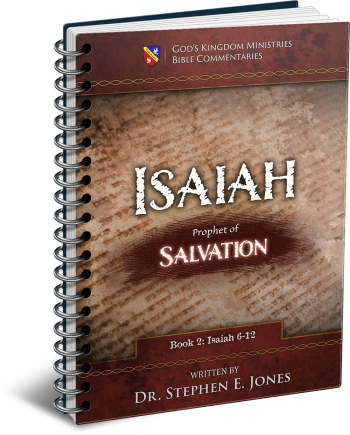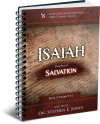Latest Posts
View the latest posts in an easy-to-read list format, with filtering options.

Isaiah is the prophet of Salvation. He is also known as the truly "Universalist" prophet, by which is meant that He makes it clear that salvation is extended equally to all nations and not just to Israel. He lived to see the fall of Israel and the deportation of the Israelites to Assyria, and he prophesied of their "return" to God (through repentance). He is truly a "major prophet" whose prophecies greatly influenced the Apostle Paul in the New Testament.
Category - Bible Commentaries

The messianic prophecy in Isaiah 9:1-3 tells us of the “great light” that was to come to Galilee. This is the light that was presented in the gospels, most notably the Gospel of John, which tells us in John 1:4, 5,
4 In Him was life, and the life was the Light of men. 5 The Light shines in the darkness, and the darkness did not comprehend it.
Jesus’ mission is seen clearly when He went back to Nazareth, His hometown, and read in the synagogue the passage from Isaiah 61:1, 2. We are told this in Luke 4:17-21,
17 And the book of the prophet Isaiah was handed to Him. And He opened the book and found the place where it was written, 18 “The Spirit of the Lord is upon Me, because He anointed Me to preach the gospel to the poor. He has sent Me to proclaim release to the captives, and recovery of sight to the blind, 19 to proclaim the favorable year of the Lord…” 20 And He began to say to them, “Today this Scripture has been fulfilled in your hearing.”
His mission to release the captives was accomplished through the light of truth, which was designed to heal the blind. The blind captives were those who walked in darkness, those who were in need of the light of truth.
His audience, however, was from Nazareth, a fiercely nationalistic town who interpreted Isaiah to mean that the Messiah would set them free from the captivity of Rome. They were not interested in new light on the word, for they believed that they already had the light. Hence, they were offended and would have thrown Jesus off the cliff, “but passing through their midst, He went His way” (Luke 4:30).
Apparently, their spiritual blindness also blinded them physically, allowing Him to escape from their midst.
Isaiah 9:4 tells us the purpose of the great light that was to be seen in Galilee,
4 For You shall break the yoke of their burden and the staff on their shoulders. The rod of their oppressor, as at the battle of Midian.
The battle of Midian was where Gideon’s army broke the power of the Midianites, whom God had raised up to oppress Israel for seven years on account of Israel’s idolatry (Judges 6:1). The Nazarenes in Jesus’ hometown no doubt interpreted Isaiah’s prophecy to mean that God would break the yoke of Rome, even as He had broken the yoke of the Midianites.
However, Jesus did not share their interpretation. He saw the physical battle of Gideon as an Old Testament type and shadow to portray a greater truth—breaking the power of darkness over those who were spiritually blind in Galilee. So when we see how Gideon won that battle through the light and revelation of the autumn feast days, we too may be enlightened.
Gideon was instructed to put a glowing firebrand into clay jars, and when he blew the trumpet, the army was to break the jars, allowing the firebrand to burst into flame. When the army did this during the night, the enemy became confused and killed each other (Judges 7:19, 20).
The blowing of the trumpets represented the Feast of Trumpets, which was to be held yearly on the first day of the seventh month (Hebrew calendar). It signified the resurrection of the dead.
Breaking the clay vessels represented the Day of Atonement on the tenth day of the month, where men were called to fast and repent of their sins. It was about breaking the power of the flesh.
The light shining in darkness represented the Feast of Tabernacles, beginning on the 15th day of the seventh month, which prophesied of the transformation and birth of the sons of God eight days prior to their presentation to the Father in heaven.
While Gideon’s army obtained a great victory over the Midianites, ending their physical captivity and oppression, this can hardly be compared to the greater victory that is ours through the light of Christ. The story was a prophecy of things to come. Even as the spring feasts prophesied of Christ’s death, resurrection, and the coming of the Spirit at Pentecost, so also the autumn feasts prophesied of the resurrection and transformation of the sons of God at the end of this age.
Paul compares us to Gideon’s army in 2 Cor. 4:6, 7, saying,
6 For God, who said, “Light shall shine out of darkness,” is the One who has shone in our hearts to give the Light of the knowledge of the glory of God in the face of Christ. 7 But we have this treasure [i.e., this Light] in earthen vessels….
In other words, we ourselves—that is, our bodies—are the clay jars in which the Light resides currently. When the jars are broken, the Light of Christ will “shine out of darkness.” There is an individual application to this as well as a historic, prophetic fulfillment at the appointed time when the full body of overcomers is complete.
This is the manner in which God will “break the yoke” and “the rod of their oppressors, as at the battle of Midian.”
Isaiah 9:5 continues,
5 For every boot of the booted warrior in the battle tumult [ra’ash, “earthquake, shaking”], and cloak rolled in blood, will be for burning fuel for the fire.
Isaiah continues his metaphor of a battle scene, but he tells us that the soldiers’ boots and their bloodied cloaks will be “fuel for the fire.” When we view this in New Covenant terms, we must compare this to the message of John the Baptist, who said in Matt. 3:11, 12,
11 As for me, I baptize you with water for repentance, but He who is coming after me is mightier than I, and I am not fit to remove his sandals. He will baptize you with the Holy Spirit and with fire. 12 His winnowing fork is in His hand, and He will thoroughly clear His threshing floor; and He will gather His wheat into the barn, but He will burn up the chaff with unquenchable fire.
The “fuel” in this case is the chaff, a metaphor which represents the flesh, that is, the nature of the first Adam and the works that proceed from the flesh. Isaiah’s prophecy speaks of the flesh and its works in terms of the boots and garments worn in battle. All of these must be burned in the fire of the Holy Spirit.
In fact, these fleshly boots must be replaced by the shoes of the preparation of the gospel of peace (Eph. 6:15).
The chaff is a necessary part of the wheat during its time of growth, as is the boot and garment of a warrior during the time of battle. However, at the time of harvest and at the end of the war, these fleshly things must be discarded and burned by the all-consuming baptism of fire. Along with these fleshly things, all fleshly interpretations of Scripture must also be cast into the same fire.
Hence, the light coming to Galilee was the truth of the word coming from Christ’s teachings. Those who sit in darkness are blind and in need of healing so that they may see the light. Breaking the yoke was really about setting prisoners free from the bondage of sin (Rom. 7:14, 23).
The anticipated coming of the dawn, the release from foreign captivity, and the battle of Midian were not meant to be repeated in our time but were just fleshly metaphors, prophetic types and shadows, to teach us greater truths that will transform us into the image of Christ. It is only when our very nature is changed that we are qualified as overcomers to rule with Christ in His throne.
The climax of this passage is found in Isaiah 9:6, 7,
6 For a child will be born to us, a son will be given to us; and the government will rest on His shoulders; and His name will be called Wonderful Counselor, Mighty God, Eternal Father, Prince of Peace. 7 There will be no end to the increase of His government or of peace, on the throne of David and over His kingdom, to establish it and to uphold it with justice and righteousness from then on and forevermore. The zeal of the Lord of hosts will accomplish this.
The “child” is Jesus Christ first and foremost. However, in His role as the Head of the body, Christ shares this calling with the sons of God, especially when that body is complete and is brought to birth at the historic fulfillment of the feast of Tabernacles. Not only is the government to rest upon the shoulders of King Jesus, but His body also rules with Him under the authority of His throne (Rev. 5:10).
Christ is first said to be the “Wonderful Counselor,” One whose counsel is so wise that it leaves us speechless.
He is also “Mighty God,” One who has the strength to carry out whatever His will desires. This also points to the deity of Christ as the Logos in John 1:1 and the “only begotten God” in John 1:18.
Christ is then said to be “Eternal Father” (Hebrew: ad ab), because even as He Himself claimed to be the Son of His heavenly Father, the sons of God are also the children of Christ. Hence, Isaiah 8:18 says of Christ, “I and the children whom the Lord has given me.” Hence, Christ is a Father in His own right.
Finally, Christ is called “Prince of Peace,” because He comes to reconcile all of creation, making peace and overcoming all enmity (Col. 1:20). In this, Christ fulfills the prophetic type of Solomon, the prince, the son of David, whose name means “peaceful.” He was a type of the Prince of Peace, and his reign saw no wars.
The increase of His government will be endless, implying that His rule will expand even beyond the reconciliation and subjection of this creation and this universe. So also the angel told Mary, “…of His kingdom there will be no end” (Luke 1:33, The Emphatic Diaglott).
He will occupy the throne of David, in spite of opposition, even as Solomon took the throne in spite of opposition from Adonijah, a type of antichrist. The throne will be established and upheld with justice and righteousness according to the laws of God, which express His nature and define the standard to which the entire universe will conform.
“The zeal of the Lord of hosts will accomplish this,” not the zeal of man, or the will of the flesh, which ultimately always fails. Zeal means that He will not give up until He has accomplished His will and purpose.
This same zeal caused Jesus to cleanse the temple (John 2:16, 17). That temple immediately reverted back to its corrupt ways, of course, but His zeal will not take no for an answer. Corruption will not stand. The new temple that He is building will be completed, made of living stones that are immortal and incorruptible.